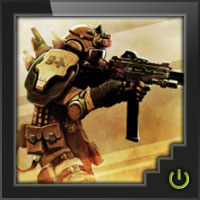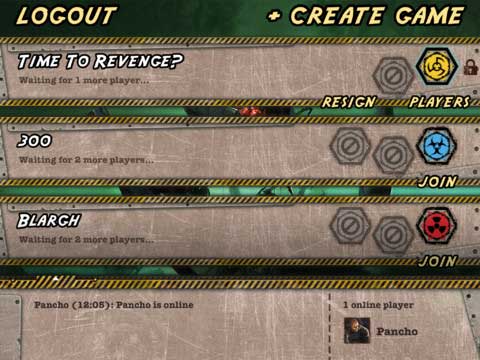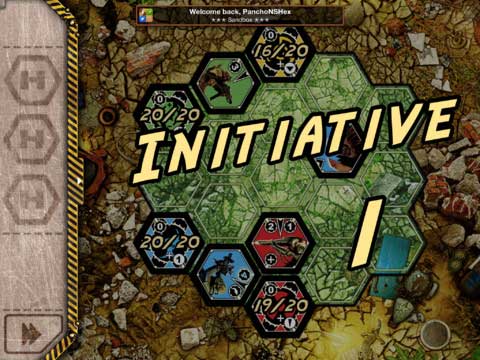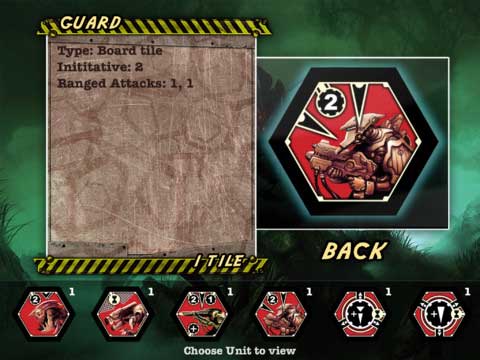
Neuroshima Hex
Dust clouds hover over the battlefield. Soldiers, urged by the officers, take their positions. Quietly, like a dark tide rising, units are moved into place and as they stop the whole battlefield freezes in silence. Suddenly battle cry of the mutant’s chief echoes in the valley, but just a second later a hidden sniper puts him to the grave. The battle begins!
Neuroshima Hex is a fast paced, tactical board game for up to 4 players, available on the iPhone, iPod Touch, iPad and Android devices. The Earth, destroyed by the greatest and most destructive war, is divided between four hostile factions:
Moloch – terrifying artificial intelligence fighting for world domination.
Borgo – powerful and brilliant leader who has managed to unite the mutants under his dark will.
The Hegemony – land ruled by gangs, where might and right are one.
The Outpost – guerillas fighting for survival in this violent and dangerous world. Each player controls one of those armies and faces his opponents controlled by other human or AI players.



Features
- Official Neuroshima Hex game with original artwork
- 6 different armies with unique strategies
- Up to 4 players (human or AI)
- asynchronous online multiplayer
- 3 AI difficulty levels
- In-game tutorial & manual
Store Links: (prices may vary)
- Neuroshima Hex for iOS (universal) - $4.99
- Neuroshima Hex Lite for iOS (universal) - FREE
- Additional armies available via in-app purchases (iOS devices)
- Neuroshima Hex for Android - $2.99
- Neuroshima Hex Lite for Android - FREE
User Reviews (5)
Add a Review for "Neuroshima Hex"
You must be logged in to add a review.


Just for background information, I haven’t played the original boardgame version of Neuroshima Hex, and I have the Android version of the game on my little 7″ tablet. I guess the iOS version may behave differently in some respects. So, what do I think of it?…
Well, the app looks nice, has an adequate tutorial and a decent rules and units reference. Plus you can either set up a random “quick” game or select up games for up to four armies, each either as human or AI players. There is also a free “Neuroshima Hex Lite” which just has two armies available which I used to learn the basics and decide that I did want to pay for the full version.
The game is fairly simple: each player gets up to three random tiles from their army each turn, of which they can play up to two. Some tiles are units which can do damage to others (including the opponent’s HQ, damaging which is the aim of the game) while others provide modifiers for other tiles in play or trigger one-off effects like battles or air strikes.
And here comes one of my biggest bugbears. The tiles have lots of iconography representing their effects and it is not always immediately obvious what it all does. That in itself isn’t a problem, but to find out you need to step back out of the game, open the army reference and look up the unit you are interested in to find out about it, then re-enter the game and continue. I have found no way to directly get information on a unit without all those steps.
While on the subject of issues, I also find it annoying that there is no “take back” option. It is very easy to accidentally discard a tile which you wanted to play, and once you have done that, well, tough luck.
Other than that, I find the game very enjoyable. There is a lot of randomness in the game due to the way tiles are drawn, but that suits me for a quick, light game (now I know how most of the units work!), and there is certainly some depth here. I’ve now got to a position with the game where I can beat the simplest AI setting about half the time, so there is still plenty of room for me to grow with this game. And I’ll certainly keep playing it.
Neuroshima Hex is a abstract hex-tile laying game where each player plays as a army trying to destroy the other players headquarters. There is a theme here, each player controls a different kind of army in a post apocalyptic future and it’s kinda scifi in a way. In Android you have four different armies that are robotic, mutant, human or blends of those kinds. However this theme is very very thinly applied in the game and the Android version does nothing to present it, you just start games and it goes straight to the tile placing and fighting. The point is that if theme is very important to you, this game is not for you, even if you like post apocalyptic war scifi.
The actions in the game are very simple, you start each game by first placing you’r hexagon headquarters on the hexagon grid map. Then each player takes turn drawing new tiles and placing them on the board until 1) the board is full and a war breaks out or 2) a player starts a war by playing a war tile and war breaks out. You draw at most three tiles at the time and then you have to discard a tile, usually a hard choice. When war breaks out all the units on the board duke it out and when the combat is resolved players continue to lay down more tiles until either they are out of tiles (after which a final war is resolved for each player) or headquarters get destroyed by going to zero hit points, each HQ starts with 20 hit points. The winner of the game is the player with the HQ that has the most hit points at the end of the game, simple enough right? Wrong!
This game was for me confusing at first, took me a good couple of plays to understand it, not sure if am 100% there yet either, and when I started to understand it it got even more complex. Each tile you place on the board is either a module or a unit, modules and units have symbols on them to represent what they do on the board. Understanding these symbols is the first basic thing you must master in order to simply understand what is being placed on the board and what it means for the combat. Melee units have short triangles to represent one hit in a certain direction, ranged units have long triangles. Each unit has a initiative number on it and maybe a toughness sign. The initiative is important because when the combat starts the higher initiative units go first, meaning if a 3 init unit stands before a 2 init unit then the 3 init unit will most likely kill the 2 init unit before it gets to do anything. All these numbers are plainly visible so when you place a unit to kill another unit the other player can respond to that by perhaps placing another unit on your unit that has a even higher initiative then yours, or simply just move or kill you’r unit with a action tile.
So each round is a continuing stream of trying to outmanouver the other player(s) and hope/know that you have the upper hand when war breaks out, wich it will, the only real certainty in the game. With the modules things get more complicated because they boost and change the stats of other units, sometimes even negatively. Each hq also acts like a module giving a boost in some form to nearby units. The game suddenly goes from very simple in very complex when you’r trying to figure out all of the bonuses and trying to place you’r units in the best manner to destroy or damage the other player(s) hq more then they are destroying yours.
When playing against a computer opponent it is easy to get a extremely fast pace with the game, a game may take 10-15 minutes or less if you’r placing tiles at a rapid pace. With a human opponent a game takes about 30-45 minutes depending on the pace. The game feels a bit like chess in that each move of one player usually engages the other player to do a counter move, also the small and tight board makes each game instantly confrontational and aggressive. On my tablet it was a brilliant travel game to either place on a table or pass around. Even tough the drawing of tiles is random and may affect the game it never really feels random when one player wins, the choices made in placing the given tiles is the real factor determining the outcome.
At first I didn’t like Neuroshima Hex because of it’s complicated and confusing symbols and very bare bones theme, as I said this was my first abstract game, but a couple of games in and I was completely hooked on it. Trying to outsmart a CPU or human opponent by placing the right tile on the right hex is a simple and addictive action that keeps me wanting to “just play one more round”. The Android implementation is solid and I hear the iOS version is even better with online play and expansions. I don’t think this game is for everyone, but I do believe everyone should at least try it (there is a free version on the Play Store, not sure about the App Store). If you like it you will probably love it.
Neuroshima Hex is digital adaptation of a boardgame of the same namesake. Players try to destroy each other’s home base tile until the game ends. If no bases are destroyed, then the base with the least damage wins. You can play up to four players or play by yourself.
PROS:
Limited rounds
Nice graphics -> looks cool
Works good on cellphone screen.
Decent AI
CONS:
Help manual doesn’t work in Android version
Maybe too random
Theme doesn’t really matter – it could just be hexes with dots and numbers.
GAMEPLAY:
Basically, each player takes turn placing their home base tile the first round on the hexagon grid. After that, you receive 3 tiles from your deck of tiles and pick one to discard. You can then place 2 tiles on the board into strategic locations. When the grid is full or if a battle tile is placed, then the battles commence. The tiles with the highest initiative points get to strike first and do damage, then the next lower initiative points go next down to your home base tile which get to attack as well. Tiles that take maximum damage are removed after each initiative phase. You do this until the tiles run out or only one base is left remaining.
The keys to the game is in positioning your tiles at the right time. Only certain tiles can attack on certain sides, so you need to rotate your army tiles appropriately. You also need to protect your base, and not leave it wide open to be surrounded by enemy units to take a beating. This is hard to do, because you have to make good decisions on which tiles to discard and which ones to play. Definitely play a battle tile if you have the upperhand as to what has been played, so you start the battle early before the grid is filled up.
CONCLUSION:
Overall, I found NH a rather fun little tactical game that appears to be hard to master. I’m still figuring what all the pieces do for just one army, don’t mind all the others sheesh. The Moloch are just brutal with all the attack angles they get. Also, the online help didn’t work on my smartphone which made it difficult to really learn the game. This game can be tense while you try to make the right decisions.
I don’t think there is an overall deep strategy, because of the random draw of tiles and having to choose two out of three. You spend more time reacting sometimes than planning. So, I don’t think this will appeal to strategy gamers. I think avid gamers and power gamers would gravitate to this kind of game especially if they plan on purchasing the expansion armies to add lots of variety.
For a smartphone app, it makes a great little timekiller.
This game took me a while to learn. Once you pick it up though, its a great game with unlimited amounts or replay value. This is a tactics game, but not really a wargame, so the people that will be happy with this game might not be the ones that would expect to like it.
I’ve been playing this game for ages and I still don’t have it all down. As a few other people have said, this game tends to keep you on your heels, reacting to the moves made by the AI instead of having the ability to plan and be strategic. Also, it takes forever to learn the abilities of even one of the factions, let alone how they move and react to the actions of your opponent.
For me this game is a great game for a smartphone. Its a great time killer, and it makes sense that it’s a phone app. If you like boardgames at all, you should get it , learn it and love it, just be prepared to lose more than a few games in the beginning while you learn how it’s played.
Just a wonderful game.